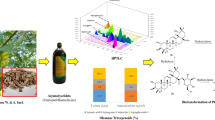Summary
A rapid and reliable HPTLC method for analysis of aristolochic acids (AA) has been developed on the basis of a TLC procedure previously published by the German Drug Codex (DAC). The new method enables visual detection of the acids with certainty at very low levels (400 pg absolute of aristolochic acid A) in plant material and can therefore be used for screening Chinese drugs to ensure their safety on the basis of the absence of AA. Qualitatively Stepha-nia tetrandra can be distinguished from various Aristolochia spp., Asarum spp., and other drugs with similar Chinese names, on the basis of fingerprints.
At least five different aristolochic acids can be detected in Aristolochia spp. The method is very specific and sensitive and is suitable for establishing and documenting adulteration of Stephania raw material with less than 1% Aristolochia fangji. By use of scanning densitometry quantitative determination of AA can be performed at low concentrations (1 ppm). Validation data (ICH) including linearity, limit of detection, precision, and accuracy are presented. The performance of the method is discussed on the basis of comparison with an HPLC-MS method proposed by the US FDA. HPTLC analysis is presented as a very useful complementary technique to the more sophisticated procedures used in legal cases.
Similar content being viewed by others
References
Working Party on Herbal Medicinal Products, Position Paper on the Risks associated with the Use of Herbal Products containing Aristolochia Species. EMEA/HMPWP/23/00, 2000; http://www.emea.eu.int/pdfs/human/hmpwp/002300en.pdf (last visited May 2004).
R. Flurer, M. Jones, N. Vela, L. Ciolino, and K. Wolnik, Determination of Aristolochic Acid in Traditional Chinese Medicines and Dietary Supplements. DFS/ORO/ORA, No. 4212. USFDAForensic Chemistry Center, Cincinnati, Ohio, http://www.cfsan.fda.gov/~acrobat/lib4212.pdf (last visited August 2004).
K. Ferenczi-Fodor, Z. Végh, A. Nagy-Turák, B. Renger, and M. Zeller, J. AOAC Int. 84 (2001) 1265–1276.
Deutscher Arzneimittel-Codex (DAC), DAC-Probe 7, Prüfung auf Aristolochiasäure in pflanzlichen Drogen. 2002, www.govi.de, dac@govi.de
S. Dentali, M. McGuffin, A. Blatter, and I. Khan, New Engl. J. Med., submitted for publication.
A. Blatter and E. Reich, J. Liq. Chromatogr. Related Technol. 27(13) (2004) 1–14.
Author information
Authors and Affiliations
Rights and permissions
About this article
Cite this article
Blatter, A., Reich, E. High Performance Thin-Layer Chromatographic Analysis of Aristolochic Acids in Chinese Drugs. JPC-J Planar Chromat 17, 355–359 (2004). https://doi.org/10.1556/JPC.17.2004.5.6
Received:
Accepted:
Published:
Issue Date:
DOI: https://doi.org/10.1556/JPC.17.2004.5.6




